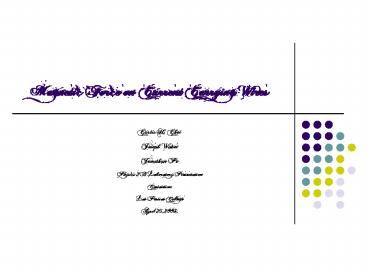Magnetic Force on Current Carrying Wires - PowerPoint PPT Presentation
1 / 19
Title:
Magnetic Force on Current Carrying Wires
Description:
'electrics' attracting various materials (Amber (G) ... Hans Christian rsted (Physicist) Accidental discovery re-linking electric and magnetic theory ... – PowerPoint PPT presentation
Number of Views:1485
Avg rating:3.0/5.0
Title: Magnetic Force on Current Carrying Wires
1
Magnetic Force on Current Carrying Wires
- Curtis H. Choi
- Joseph Wassei
- Jonathan Po
- Physics 2B Laboratory Presentation
- Costantino
- Las Postias College
- April 25,2003.
2
Background
- History of Magnetism
- Magnesia
- Lodestones attract pieces of iron
- Chinese
- Compasses made of lodestones
- William Gilbert (1500s)
- Artificial magnets, by rubbing lodestone and iron
- electrics attracting various materials (Amber
(G)) - Static electrical attraction to a magnetic
attraction - Electrical attraction may be transmitted through
an object
3
Background
- History of Magnetism cont.
- Hans Christian Ørsted (Physicist)
- Accidental discovery re-linking electric and
magnetic theory - Ampére (Mathematician)
- Source of magnetic field is electric current, as
the source of an electric field is an electric
charge - Magnetic field (B) around a wire is proportional
to the current flowing through the wire - Right hand rule
- Two current-carrying wires attract/repel
depending on direction of current
4
Theory
- Interaction between a moving charge and a
magnetic field can be described as followed - FqvBsin? (Eqn. 1)
- q magnitude of moving charge, v velocity B
magnetic field - Extended using cross-sectional area A and Length
L carrying current I - F qvdB (Eqn. 2)
- vddrift velocity
5
Theory
- Since VAL the number of carriersnAL the
magnitude of total magnetic force on a wire with
length L is - F(qvdB)(nAl) (Eqn. 3)
- Since InqvdA, F may be expressed
- F ILBsin? ILB (Eqn. 4 5)
- Assumptions made in our experiment none of the
electrons escape into the atmosphere, also
neglect all forces on magnetic holder other than
gravitation and electrical (magnetic)
6
Experimental Arrangement
- Obtain the following equipment
- Basic Current Balance and Accessory
- Quadruple-Beam Gram Balance
- DIGI Power Supply
- DMM
- Patch cords
7
Experimental Arrangement
Assemble apparatus (used in Part A C)
8
Experimental Arrangement
- Part A
- Assemble apparatus
- Determine and record the mass of the magnet
holder and magnets with no current flowing (m0).
Magnet holder
Magnets
9
Experimental Arrangement
- Part A
- Assemble apparatus
- Determine and record the mass of the magnet
holder and magnets with no current flowing (m0).
- Measure the new mass of the magnet assembly in
different current settings (0.5amp 2.0amp
increasing the current in 0.25 increments).
10
Experimental Arrangement Part B
- Part B
- Determine and record the length of the
conductive foil on the current loop (L). - Determine the new mass of the magnet assembly
at 2.0amps current and record it as m(L). - Subtract m0 from m(L) and record as F(L).
- Repeat the above steps with all the other current
loops.
11
Experimental Arrangement
- Part C
- Mount a single magnet in the center of the
holder. - Determine the mass of the magnet assembly
without current flowing and record as m(n). - Set the current to 2.0 amps. Determine the new
mass of the magnet assembly and record it as
m(n,c). - Subtract m(n) from m(n,c) and record the
difference as F(n).
12
Experimental Results
- This apparatus was used in Part A Force vs.
current, Part B, Force vs. length of wire, and
Part C Force vs. magnetic field. - Magnetic holder weight(m0) .1614 Kg
Quadruple-beam balance
Current loop
Main unit
Magnetic holder
13
Part A Force vs. Current
- The equation of the graph is Y .0002x - 2E-6.
- The slope of the line was found to be .0002 LT.
- The slope of the line is LB from the equation
(F/I)LB. - This equation tells us that if the current
increases so does the force acting on the wire.
14
Part A Force vs. Current
- The equation of the graph is F sI F0
- The slope of the line is s BL 2.xx(10-4)
N/A - For L 2.00 cm, B 0.076 T
15
Part B Force vs. Length of Wire
- The equation of the graph is Y.0432x - .0004.
- The slope is .0432 A T.
- The current was 2.0 Amps
- The slope of the line is IB from the equation
(F/L)IB. - As length of wire increases so does force acting
on the wire. - Equation
- slopeBI
- B .0432/2 .0216 T
16
Part C Force vs. Magnetic Field
- The equation of the graph is y 7E-7x 4E-5.
- The slope of the graph is 7E-7 N per magnet.
- As the number of magnets inc. so does the Force
in the magnetic field.
17
Errors
- Possible errors in this experiment are
- The quadruple-beam balance was not calibrated
correctly. - Length of the conductive wire measured might have
been measured incorrectly.
18
Conclusion
- The magnetic field was found to be .0216 T using
the equation slope BI - It was found that as the current, number of
magnets, and the length of the conductive foil
inc so does the force in the magnetic field.
19
Magnetic Force on Current Carrying Wires
- Curtis H. Choi
- Joseph Wassei
- Jonathan Po
- Physics 2B Laboratory Presentation
- Costantino
- Las Postias College
- April 25,2003.































